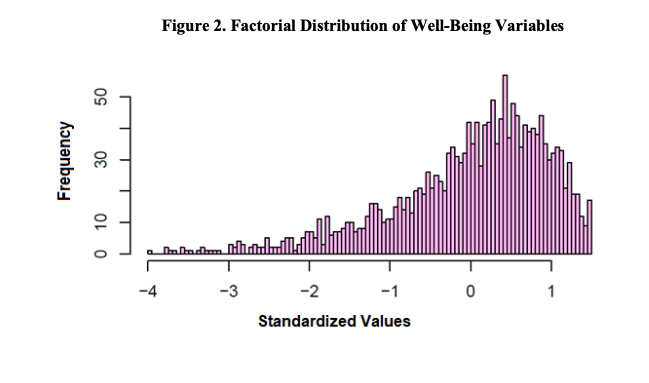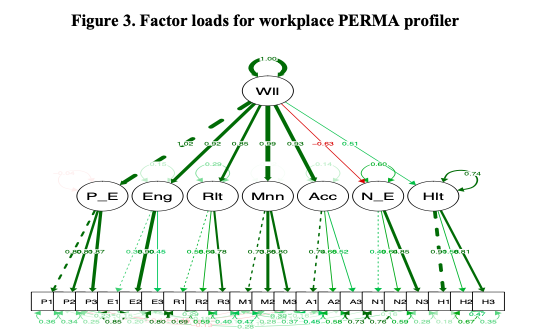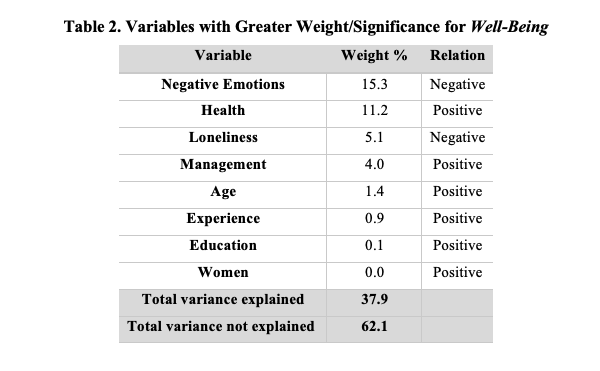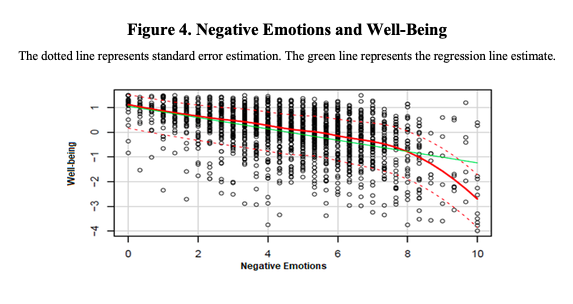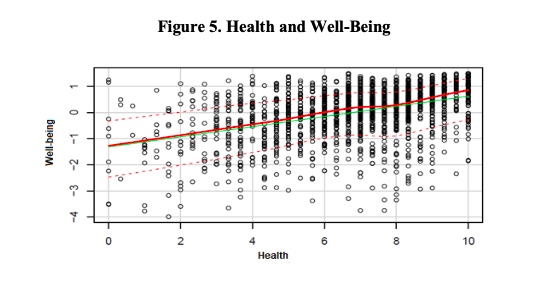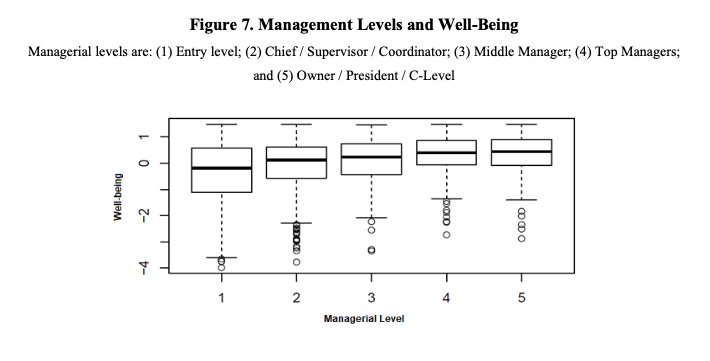Camelia Ilie-Cardoza, Associate Professor, INCAE Business School; Guillermo Cardoza, Professor, INCAE Business School; Ramiro Casó B, Senior Researcher, INCAE Business School; Andrés Fernández, Senior Researcher, INCAE Business School
Contact: camelia.ilie@incae.edu
Abstract
What is the message?
Understanding the role that work and work-related activities have on the development of personal well-being is a critical aspect for organizations and professionals in the workplace. This work provides evidence that, while the models of well-being proposed by researchers in developed countries are relevant to organizations in developing countries, well-being in the workplace in Latin America is still related to the absence of negative emotions or experiences. The research identifies the need to redefine the social script of the workplace and its role in people’s well-being.
What is the evidence?
A confirmatory factor analysis conducted on Positive Emotions, Engagement, Relationship, Meaning, and Accomplishment (PERMA) for workplace scale on professionals showed that Seligman’s model of well-being seems to have a good fit within a Latin American context. A preliminary estimation of a regression model and a decomposition of the variance showed that negative variables are the ones that contribute the most to current well-being in Latin America, calling for a need to redefine the social script related to work.
Submitted: April 16, 2020; accepted after review and revision: April 26, 2020
Cite as: Camelia Ilie, Ramiro Casó, Guillermo Cardoza, Andrés Fernández (2020). Well-Being in the Workplace: An Exploratory Study in Latin America. Health Management, Policy and Innovation (www.hmpi.org), Volume 5, Issue 2, Spring 2020.
Happiness is when what you think, what you say and what you do are in harmony.
— Mahatma Gandhi
Achieving Work-Related Well-Being Is a Challenge
Despite the amount of change and uncertainty that characterize the world today, optimistic scenarios in which innovative industries see accelerated growth and have a motivated and empowered workforce are possible, even in a post-coronavirus world. There is, however, another challenge that needs to be addressed for these scenarios to become a reality—namely, a new definition of work-related well-being. According to a study conducted by Gallup in 142 countries, only 13% of the employees surveyed said that they were actively engaged with their work. Likewise, an alarming 24% said that they were actively “unengaged,” while the remaining 63% were indifferent. According to Gallup, these results represent losses of more than $500 billion in the US alone (1).
More recently, Campbell and Poquet (2) studied the relationship between decent work and life satisfaction. Decent work, as defined by the International Labor Organization, can be understood as the “promotion of opportunities for women and men to obtain productive work in conditions of freedom, equity, security, and human dignity” (2). Their findings suggest that the material components of decent work account for roughly 50% of reported life satisfaction, leaving the other 50% to the non-material components of decent work.
The Gallup study illustrates a contradiction that raises essential questions. In an apparently favorable context with various powerful tools increasingly available to a greater number of people, why is there such a high level of detachment and demotivation in the workforce? What is the underlying psychological process, and how can it be measured? What is the impact on the results of an organization? Moreover, what are the implications for a developing region, such as Latin America? Campbell and Porquet’s study offers initial answers to those questions, but it is clear that further research is needed since the majority of studies have been conducted in developed nations.
Work-Related Well-Being: New Drivers, New Challenges
Understanding an apparent contradiction
The first step in finding answers to the questions concerning work-related well-being is to understand the apparent contradiction that emerges from the Gallup study. Why are so many professionals dissatisfied with their jobs even though they now have better training, management tools, and more resources overall? A possible response is that technological advances have changed the factors that drive labor motivation. Diener and Seligman (3) propose the following explanation:
Because goods and services are abundant today, our basic needs in modern societies are practically satisfied. People can afford to refocus their attention on the “good life” – an enjoyable life that has meaning and allows for fulfillment – by using the economy and other policies at their disposal. This “refocus” is justified because there is evidence that as societies become wealthier, they often experience an increase in mental and social problems, as well as a stagnation (or plateau) in the satisfaction of their life (p.2).
It is evident that in the past, work was a necessity, and people’s approach to it was rather pragmatic. Today, the same pragmatism does not necessarily hold. People seek much more than adequate and guaranteed remuneration in their work: they seek a “good life.” What does that mean for today’s workforce, and what expectations do people have? Similarly, as mentioned above, Campbell and Porquet (2) argue that the non-material dimension of work matters, and, therefore, a traditional, more economically oriented vision of work is not sufficient to promote work engagement and overall satisfaction.
Beyond happiness: Well-being as a multidimensional concept
Over the past 20 years, a group of pioneering psychologists, including Martin Seligman (4), Shawn Achor (5), Sonja Lyubomirsky et al. (6), and Tal Ben-Shahar (7), have shaped a vast body of theories grouped under what is now known as Positive Psychology. This discipline can be defined as a field of science that studies the optimal functioning of individuals, groups, and organizations (8).
One of the central concepts in Positive Psychology is well-being, understood as positive and lasting characteristics that allow individuals and organizations to prosper (4). Well-being is a dynamic concept that includes not only subjective, social, and psychological dimensions, but also behavioral, health-related, and economic aspects.
One of the most widely cited theoretical models on well-being was developed by Martin Seligman and his colleagues at the University of Pennsylvania (4,9). According to Seligman, well-being is a construct, not a real thing. It is comprised of different measurable components, each of which is a real thing that contributes to well-being.
The five components of Seligman’s model are Positive Emotions, Engagement, Relationship, Meaning, and Accomplishment—known as “PERMA.” One of the most valuables aspects of the model is that it assumes that well-being is a comprehensive concept encompassing different but equally valuable aspects of human flourishing and life satisfaction. This becomes clear when each component is analyzed separately.
- Positive emotions: Positive emotions refer to emotions such as joy or pleasure. The more often a person experiences a positive emotion, the more well-being he or she will have. This component improves work performance, promotes a better state of health, strengthens social relationships, and generates optimism for the future.
- Engagement: Engagement refers to the attachment and concentration that a person experiences when performing a specific activity. A key concept related to engagement is Flow, proposed by the Hungarian-American psychologist Mihaly Csikszentmihalyi (10). Flow is defined as the psychological state of a person whose skills are aligned with the demands of a task she performs. Flow is a state of absolute immersion in the present, which contributes to well-being.
- Relationship: Having a robust social network consisting of friends, colleagues, and family constitutes the Relationship component of well-being. The stronger these networks are, the more well-being a person will experience.
- Meaning: Meaning refers to people’s need to be part of something bigger than themselves. When people invest time and energy in tasks that transcend personal goals, such as volunteer activities or doing something for the good of their community, they experience an increase in well-being.
- Accomplishments: Lastly, to achieve well-being, people must be able to look back on their lives and feel that they have achieved their goals. Individuals pursue success or Accomplishments independently of other components, such as positive emotions or relationships. The feeling of being productive and being able to trace and reach goals is a significant component of well-being.
Seligman’s model allows for an objective approach to well-being. As such, it allows for the possibility of diagnosing and implementing corrective measures to improve each of the different components that generate well-being.
Is it possible to derive well-being from our jobs?
Extensive research has explored how employees’ level of well-being affects critical aspects of the working world. In that vein, several studies have shown that employees with low well-being are less productive, make poor decisions more frequently, miss work more often, and make substantially smaller contributions to the organization. Increased well-being helps reduce the risk of suffering from mental disorders and, at work, also increases performance, improves the quality of interpersonal relationships, and increases motivation and engagement (and/or flow) (8). Indeed, a meta-study on the impact of well-being, which compiled more than 200 investigations conducted with more than 275,000 participants, showed that well-being is a predictor of success in almost all areas of people’s lives, especially in the workplace, in the development of professional careers, and in business (5).
The evidence seems to indicate that rather than being just a consequence of success, well-being may be one of its causes. Hence, as Diener and Seligman (3) point out, most of today’s organizations recognize the importance of cultivating and measuring well-being, as well as promoting employee prosperity, as one of the elements of great strategic importance in managing talent to achieve productivity and business growth. In turn, the study of well-being has become essential at several of the most prestigious universities in the world—including Yale,[i], [1] Harvard[2] and U.C. Berkeley[3]—which offer increasingly popular programs on the subject.
Therefore, it is essential to study and understand the impact that well-being has on organizations since their future success may depend on it. As Achor (5) points out, once organizations accept this new concept—that well-being enhances success—they can change how people work, interact with colleagues, and lead teams. Such changes, in turn, will give people and organizations a real competitive advantage.
Well-Being and Work in Latin America
Latin America is a region fraught with challenges due to enormous social and economic disparities and heterogeneity. Like other regions of the world, Latin America is involved in the immense process of transformation resulting from technological advances and the cultural and social changes that they entail. Therefore, more than ever, companies are pushed to adapt their business models and understand the key variables that increase their probability of success in a changing environment. As we have shown, well-being is one of these critical variables.
Unfortunately, thus far, little has been done in Latin America to understand this critical concept and its impact on the companies and industries of the region. For example, Ed Diener and colleagues recently published a review of subjective well-being, presenting evidence on the relationship between high subjective well-being and positive job outcomes, such as job satisfaction, less turnover, and increased citizenship. However, as the authors put it: “We know only a little about the cross-cultural generality of the findings. Most of the research has been conducted in highly economically developed western nations. As happiness is highly valued in these nations, we do not know whether the findings might also apply in Africa, South America, or Asia” (11).
The current study in intended to be a step in that direction. Its objective is to make an initial assessment of the well-being of the region’s professionals to identify areas of opportunity and to start developing possible interventions. The road is long, but science provides the theoretical and methodological tools for facing this interesting challenge. There are reasons to be optimistic and confident that the findings of this study and future research will allow the region to move forward on the development path that it needs to follow in this changing world.
Study design
We gathered data using the PERMA for workplace scale developed by Butler and Kern (2014, 2016). The scale consisted of a 23-item measure that assesses well-being across five domains (positive emotion, engagement, relationships, meaning, accomplishment). Butler and Kern validated the instrument, which presented acceptable reliability, cross-time stability, and evidence for convergent and divergent validity in studies that had, in total, over 30,000 participants. In our study, respondents were taken from a non-probabilistic sample of 1757 individuals. The respondents agreed to answer the questionnaire through the Facebook application or via email. Our final sample was 41% male and 59% female. All of the respondents were employed or had their own business, according to their account status.
Their managerial or work experience was distributed as follows: 28% had less than 3.5 years of managerial experience; 23% had between 3.5 and eight years; 25% had between 8.5 and 16.5 years; and, finally, 24% had over 16.5 years of managerial experience. Finally, 54% of the respondents were from Costa Rica, 11% from Perú, 10% from Ecuador, 9% from Colombia, and the remaining 17% from the other Latin Americas countries. The questionnaire consisted of 15 items that measured the five major components of well-being, according to the theoretical framework that was used for the study (13). The questionnaire also had an additional eight items that sought to measure complementary constructs that may be related to well-being.
The database collected in our study includes the variables required to approximately measure well-being in the workplace, according to the theoretical framework of the PERMA model (4,13). As outlined earlier, this well-being model divides the concept into five primary constructs: positive emotions, engagement, relationships, meaning, and accomplishment. Figure 1 shows these relationships: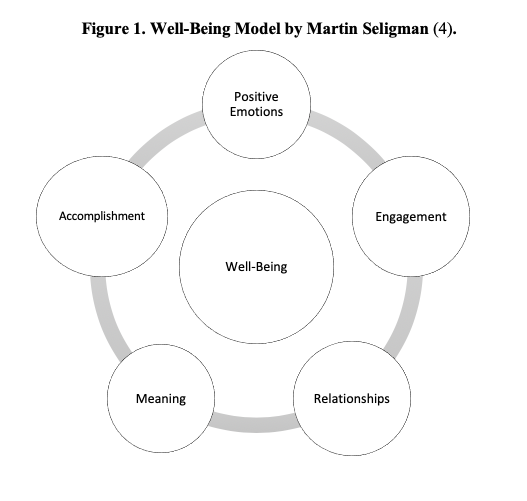
We divided the analysis into two parts. First, we wanted to validate the model in Latin America. Although the model has been tested and used in other countries and contexts, we used a statistical technique called Confirmatory Factor Analysis (CFA) to validate the fact that it fits the data collected in Latin America. CFA is a data reduction technique used to find homogeneous groups of variables (14) in order to identify the latent variables described in the PERMA model.
Second, we used regression analysis to evaluate which of the variables contributed the most to the well-being of our participants in order to have an initial, but robust, approach for understanding well-being in the region.
Results: Analysis and model validation
The CFA confirmed that the factorial model we used adjusts to the data collected in the study. We summarize the results here.
The CFA showed that the most critical factors in the generation of the model are Positive Emotions and Meaning (with factorial loads greater than 0.90), which confirms the structure seen in the correlation matrix. The matrix of correlations between the different factors (Table 1) shows a high correlation between Positive Emotions and all the other factors. Likewise, the matrix shows a high correlation between Meaning and all the others, except for the Relationships.
After verifying the structure, we generated the Well-Being construct using factorial scores specific to the factorial structure. This was done by taking the structure, weights, and other statistical relationships into account (Figure 2).
The results show an asymmetric distribution with a high concentration of values in the upper part of the distribution. This means that, in general, all the individuals in the sample have high levels of well-being. However, the distribution of the well-being variable according to the factor analysis has considerably more advantages when modeling the construct.
The Root Mean Square Error of Approximation (RMSEA), which is used to test model fit, was 0.051, with confidence intervals of 0.048 and 0.055, meaning that the model has a good fit. Each of the 21 subconstructs or items used in the model (three for each of the seven variables on the scale) had factorial loads above 0.3, showing a strong relationship among them.
Perhaps more importantly, all of the main subconstructs, or variables, presented factorial loads above 0.5 relative to well-being. Positive emotions, engagement, relationships, meaning, and accomplishment—the variables initially identified by Seligman—presented high factorial loads, showing a strong relationship with the main variable. As expected, negative emotions had a negative but still high factorial load. Finally, health presented the lowest factorial load, albeit still high according to CFA standards. Figure 3 summarizes these findings.
Variable contribution
We performed a preliminary estimation of a regression model and a decomposition of the variance of well-being. We also analyzed the relationship that other variables, such as demographic characteristics or variables external to the model, had with the construct of well-being. Results are in Table 2:
The model included eight variables to explain differences in well-being. Together, these variables explained 37.9% of the well-being variance. We found three variables with a high weight of explanation of the variability: negative emotions, health, and loneliness. The synthesis of each of these is as follows:
- Having negative emotions is the factor that most relates to a person’s well-being. The relationship is inversely proportional: the less negative a person is, the more well-being he or she enjoys (Figure 4).
- A person’s self-perceived state of health is the second factor that most relates to his or her level of well-being. The relationship is direct: the better the state of self-perceived health, the more well-being the person enjoys (Figure 5).
- Loneliness is the third most important factor related to well-being. The relationship is inversely proportional: the less loneliness the person experiences, the greater the well-being (Figure 6).
In addition to these three influences, a person’s position in the managerial hierarchy is the other factor that most relates to well-being (CEOs claim to have higher well-being than junior professionals, coordinators, or personnel supervisors). Figure 7 shows that the higher the manager’s position, the greater reported level of well-being (and less variability thereof).
Other variables, such as age and work experience, each contribute only approximately 1% to the total variability, while education, gender, and country of origin do not relate to well-being in a multivariate model.
Concerning the analysis of the results by gender, although women report slightly higher levels of well-being than men when the other factors are taken into account, these differences disappear regardless of the level of education or the country.
Finally, in a model with interactions, we found combinations that further enhance the differences in people’s perception of well-being:
- When negative emotions and poor health act together, they trigger more significant deterioration in a person’s well-being.
- Levels of loneliness vary according to managerial experience: individuals with more managerial experience exhibit higher levels of loneliness.
Four implications
This study identifies four preliminary findings of significant relevance to managers and companies in our region.
Relevance for Latin America: Seligman’s model of well-being seems to have a good fit within a Latin American context. Respondents showed overall high levels of well-being in the workplace. When we take factorial loads into consideration, positive emotions and meaning have the highest loads (1.02 and 0.99 respectively), which means that well-being in the workplace is defined mostly by these two factors. Conversely, health and negative emotions (0.5 and -0.64) have the lowest loads but are still considered high by CFA standards. It would be interesting to compare general well-being measures with workplace well-being to identify possible relationships among these variables. In other words, there is great value in determining the extent to which workplace well-being contributes to general well-being in our region.
Negative relationships: Well-being as a construct in our region seems to be mostly related to variables that are negative in nature. Indeed, negative emotions, health, and loneliness were responsible for the most significant amount of the explained well-being variance. One possible explanation is that people in the Latin American region still associate well-being in the workplace with the absence of problems. Also, external variables such as experience and managerial position presented very low explanatory power.
This calls into question the nature of work in our region and how much it contributes to people’s well-being. That is, people do not necessarily think of their jobs as a source of well-being, possibly because they do not associate their work with any of the five components defined in the model. Instead, they seem to have a sense of well-being as long as they experience fewer negative emotions, such as anger, sadness, or anxiety, and are less socially isolated. It is still common in the region to regard work as something one must do even if one does not like it or does not derive any pleasure from it.
It is not surprising, then, that the variation in well-being is related to the absence or presence of these kinds of emotions. However, most importantly, it is clear that there is room for change, as people will likely respond positively—that is, with a feeling of greater well-being—if organizations pay special attention to activities and decisions oriented toward promoting positive emotions, engagement, healthier and stronger relationships, a deep sense of meaning and purpose, and alternatives routes to success.
Building on these points, two additional implications are relevant for companies and professionals.
Organizations can shape well-being: Following Achor (15), these results serve as evidence of the importance for organizations to adjust the prevailing social script that undermines a positive environment and positive behaviors in the workplace. According to Achor, most organizations are focused on problem-solving and paying attention to things that are, or could be, wrong. This problem-oriented approach leaves little space for positive emotions and reinforces more-negative attitudes and behaviors. Instead, Achor argues that companies should incorporate a positive social script—one that prioritizes not mistakes, but successes, thus leaving room for positive emotions.
Seligman’s factors could serve as a guide. For instance, managers could design activities to increase the probability of experiencing positive emotions, such as joy or pride. Also, corporate communication efforts could be implemented to highlight the role of the company in society and how each employee contributes to fulfilling this role, thus generating a sense of meaning. Finally, companies should focus more on providing robust health services for their employees, as well as activities that enhance social networks within their organizations, breaking silos and fostering interaction.
Measuring well-being: Finally, Seligman´s model serves as a framework that managers could use to measure well-being in their organization. This will allow them to run diagnostics and design measures for specific components of well-being that need to be improved. Having systematic and continuous measures of well-being could also allow companies to determine the effect of well-being (or its lack thereof) on performance.
Limitations
Further research can address limitations of our study. First, it would be desirable to conduct research to determine the relationship between well-being and specific performance measures, such as revenue or cost reductions. Secondly, cultural differences among the Latin American countries are significant, therefore, a more detailed study on specific countries or sub-regions (Andean, for example) would be useful. In doing so, it would be interesting to see how cultural context relates to individual differences.
Looking Forward
Our results provide a first approximation of the study of well-being in the workplace in Latin America. Data suggest that the PERMA model serves to accurately assess well-being, providing new opportunities to study and design measures that could increase it. We are confident that our study will not only contribute to the debate on the importance of well-being in management, but will also encourage new research and, in that way, positively transform companies in Latin America.
References
- Deaton A. Income, health, and well-being around the world: eivdence from the Gallup World Poll. J Econ Perspect. 2008;22(2):53–72.
- Campbell D, Porquet RMG. Well-Being and the labout market from a global vier: it’s not just the money. In: Glatzer W, Camfield L, Moller V, Rojas M, editors. Global Handbook of Quality of Life: Exploration of Well-Being of Nations and Continents. New York: Sringer; 2015. p. 351–79.
- Diener E, Seligman M. Beyond Money Towrd and Economy of Well-Being. Psychol Sci. 2004;5(1):1–31.
- Seligman M. Flourish: a visionary new understanding of happiness and well-being. New York: Simon and Shuster; 2012.
- Achor S. The Happiness Advantage. 1st ed. New York: Crown Publishing; 2010.
- Lyubomirsky S, King L, Diener E. The benefits of frequent positive affect: Does happiness lead to success? Psychol Bull. 2005 Nov;131(6):803–55.
- Ben-Shahar T. Happier. McGraw-Hill Companies.; 2007.
- Kun Á, Balogh P, Krasz KG. Development of the work-related well-being questionnaire based on Seligman’s PERMA model. Period Polytech Soc Manag Sci. 2017;25(1):56–63.
- Seligman M. PERMA and the building blocks of well-being. J Posit Psychol [Internet]. 2018;13(4):333–5. Available from: https://doi.org/10.1080/17439760.2018.1437466
- Csikszentmihalyi M. Flow: the psychology of optimal experience. New York: HarperCollins. New York: HarperCollins; 2009.
- Diener E, Oishi S, Tay L. Advances in subjective well-being research. Nat Hum Behav [Internet]. 2018;2(4):253–60. Available from: http://dx.doi.org/10.1038/s41562-018-0307-6
- Butler J, Kern ML. The PERMA-Profiler: A brief multidimensional measure of flourishing. Int J Wellbeing. 2016;6(3):1–48.
- Butler J, Kern ML. The workplace PERMA Profiler: Margaret L . Kern, University of Pennsylvania. 2014;(October):1–2. Available from: http://www.peggykern.org/uploads/5/6/6/7/56678211/workplace_perma_profiler_102014.pdf
- Fernández Aráuz A. Aplicación del análisis factorial confirmatorio a un modelo de medición del rendimiento académico en lectura. Rev Ciencias Económicas. 2015;33(2):39.
- Achor S. Why can’t we all be happy at work. Training Magazine. 2015;(February 2015).
[1] Yale’s “The Science of Well Being” course is now available at https://www.coursera.org/learn/the-science-of-well-being
[2] Harvard’s “The Science of Happiness” can be explored at https://gened.fas.harvard.edu/classes/science-happiness
[3] Berkeley offers an online open program titled “The Science of Happiness” that can be accessed at https://ggsc.berkeley.edu/what_we_do/event/the_science_of_happiness


